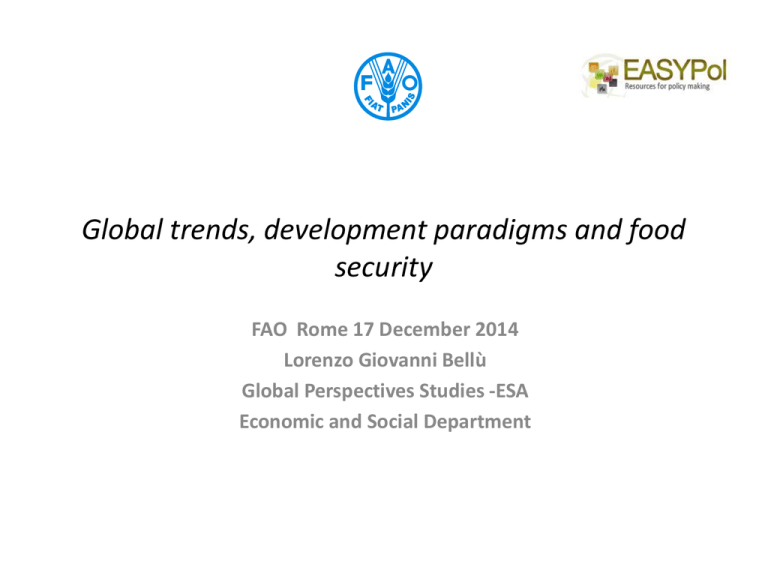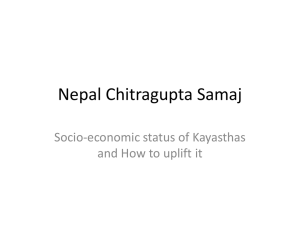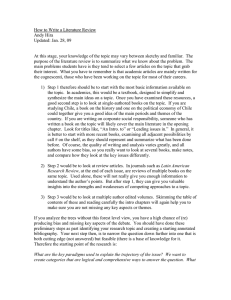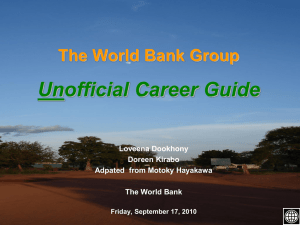Global trends, development paradigms and food security
advertisement

Global trends, development paradigms and food security FAO Rome 17 December 2014 Lorenzo Giovanni Bellù Global Perspectives Studies -ESA Economic and Social Department Outline 1. Global trends 2. Trends in agricultural trade in CIS countries 3. Food and Nutrition Security in a countrywide framework 4. Development and development paradigms 5. Questions 2 of 15 Population Incremental population growth 2005/07-2050, millions (left-axis) Percent population growth 2005/07-2050 (right-axis) 1,400 140 131 1,200 120 1,000 100 800 80 68 600 60 48 400 40 30 200 15 20 6 0 0 sub-Saharan Africa South Asia East Asia Near East & N. Africa Latin America Developed countries Source: United Nations Population Division (2009). 3 of 15 GDP 1. Global GDP is projected to increase 2.5 times to 2050 2. Per capita GDP 1.8 times 3. Faster Growth is expected in less industrialized countries 4. This is an almost BAU scenario (Source WB Development Prospects Group) 4 of 15 Source of growth of agricultural production Land Cropping intensity Yield 100 90 80 70 60 50 40 30 20 10 0 Developing countries sub-Saharan Near East & N. Latin America Africa Africa South Asia East Asia World 5 of 15 Global production and trade 1. Increased production is expected from Yield changes 2. Selected regions are expected to be net importers (S.S. Africa, South Asia) 3. Others, net exporters (e.g. Latin America, Central Asia) 4. Faster Growth is expected in less industrialized countries 5. This is an almost BAU scenario (Source WB Development Prospects Group) 6 of 15 CIS countries: Net export projections Russia Net Exports 000 tons 40,000 30,000 GRA 20,000 TUB FRU VEG 10,000 LIV OTH 2006 2015 2030 2050 2080 -10,000 -20,000 7 of 15 CIS countries: Net export projections Central Asia C., Net Exports 000 tons 4,000 3,000 GRA 2,000 TUB FRU 1,000 VEG LIV OTH 2006 2015 2030 2050 2080 -1,000 -2,000 -3,000 8 of 15 CIS countries: Net export projections Non-EU Est-Europe. N.exp 000 tons 40,000 35,000 30,000 GRA 25,000 TUB FRU 20,000 VEG LIV 15,000 OTH 10,000 5,000 2,006 2,015 2,030 2,050 2,080 -5,000 9 of 15 development paradigms Growth and poverty reduction Free market trickle-downgrowth Pro-poor (inclusive) growth Agriculture versus growth Low-wage industry-led development Low-wage import substitution Low-wage labour exportled devt. Emigration based development Technology changes and growth Endogenous growth based development Foreign Direct Investment based devt. Agriculture, technology and poverty reduction Agriculturebased development Rural / territorial development Agricultural commodities export-led External factors-based development Strategic opennessbased devt. Exhaustible resources export-led “Washington consensus” based devt. Immigration based development Foreign AidBased Inv based devt. 10 of 15 10 Development paradigms defined A “Development paradigm” is a specific (codified, recognizable) modality to achieve development comprising: • A “vision” regarding a (desirable or likely) future state of a socio-economic system, often materialized through “storylines”; • A set of objectives, to be achieved to concretize the vision; • Selected assumptions regarding the way a socio-economic system “works” (who does/will do what, why, how, for how long, often comprising key cause-effect relationships; • A set of policies (interventions, actions) aimed at achieving the desired objectives. 11 of 15 How a socio-economic system works: elements and linkages Human resources natural resources Indirect taxes Savings Factor- resource Markets Taxes Value Added Activities Households Enterprises Profits Outputs Inputs Government Imports Remittances Expatriated profits SavingsInvestment. Investment (t+2)... Investment (t+1) Investment (t) Domestic Transfers Commodity-service markets Final consumption Exports Man-made capital Internat. transfers Current external balance (+/-) Rest of the World National and international institutional set-up 12 of 15 Impacts of different policy measures on the whole system Factor and resource policies Poverty - food security policies Human resources Monetary policies Fiscal policies natural resources Indirect taxes Man-made capital Savings Factor- resource Markets Taxes Value Added Activities Households Enterprises Profits Outputs Inputs Commodityservice markets Exports Government Investment (t+2)... Investment (t+1) Investment (t) Domestic Transfers Final consumption Imports Remittances Expatriated profits SavingsInvestment. Internat. transfers Current external balance (+/-) Rest of the World National and international institutional set-up Technology and marketing policies Domestic Price policies Trade, FDI and exchange rate policies Public Investment polices 13 of 15 Questions for the working groups 1) Visions and storylines. How do you see your country (or groups of countries) in 25 years? Describe in few words two plausible “stories” (one more optimistic, the other more pessimistic), keeping into account both domestic and external factors. 2) Current and future functioning of the socio-economic system. What are the main features of the socio-economic system of your country (or group of countries)? Describe what are the current and future “engines” of development. (Who is doing what and how to make these engines work? What is the role that external factors may play? Is the situation drastically going to change in the medium-long term? ) 3) Prospects for food security. Which prospects (challenges) do you see for Food and Nutrition Security in the short, medium and long run? Can you identify possible dos and donts to ensure FNS in the long run? Explain, possibly with reference to the features of the socio-economic system. 14 of 15 Useful references Alexandratos, Nikos and Jelle Bruinsma (2012), “World Agriculture Towards 2030/2050: The 2012 Revision,” ESA Working Paper, No. 12-03, June, FAO, Rome. Bellù, Lorenzo Giovanni (2011). Development and Development Paradigms. A (reasoned) review of prevailing visions. FAO EASYPol series n. 102 www.fao.org/easypol 15 of 15


